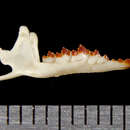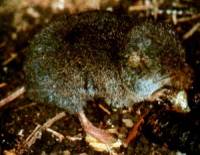en
names in breadcrumbs


Perception Channels: tactile ; chemical
This species is fairly common, and not considered in need of special conservation efforts. Because it is so rare in the spate, it is considered a Species of Special Concern in Michigan.
US Federal List: no special status
CITES: no special status
State of Michigan List: special concern
IUCN Red List of Threatened Species: least concern
Smoky shrews eat a wide variety of insects. They also eat earthworms, spiders and some fungi. In captivity they will also eat plethodontid salamanders, but it is not known if they seek them in the wild.
Animal Foods: insects; terrestrial non-insect arthropods; mollusks; terrestrial worms
Other Foods: fungus
Foraging Behavior: stores or caches food
Primary Diet: carnivore (Insectivore )
Smoky shrews are found in the eastern United States and Canada. In Canada they range from the eastern shore of Lake Superior east to the Atlantic Ocean and south to the U.S. border. In the U.S. they are found in New England, south along the Appalachian Mountains to the western tip of South Carolina, and west of the mountains into Kentucky and central Ohio. The species has only been found in one location in Michigan, on Sugar Island in the St. Mary's River, between the Upper Peninsula and Ontario.
Biogeographic Regions: nearctic (Native )
Smoky shrews generally live in the leaf litter on the floor of deciduous and coniferous forests. They are often found near rotting logs or moss-covered rocks. They have also been observed in bogs, swamps and grasslands.
Habitat Regions: temperate ; terrestrial
Terrestrial Biomes: savanna or grassland ; forest ; mountains
Wetlands: bog
Average lifespan
Status: wild: 1.0 years.
Smoky shrews get their name from the gray or black color of their body fur in winter, in summer it is dull brown. The fur on their belly is usually the same color as the back, or a little lighter. One distinctive trait is it's bicolored tail: dark on top, but tan underneath. Total length is 110 to 126 mm, tail length 42-52 mm. Adults weigh 6-11 g. Like all shrews they have a long, cone-shaped snout, many sharp teeth, small (but functional) eyes, and fur that is short but soft and dense.
Range mass: 6 to 11 g.
Range length: 110 to 126 mm.
Other Physical Features: endothermic ; homoiothermic; bilateral symmetry
Reproductive season extends from March to October. Smoky shrews never reproduce in their first year, but rather overwinter as subadults. Their gestation period is less than three weeks and birth is followed by immediate postpartum estrus. Litter size can range from 2 to 8, average is 6.
Smoky shrews start mating in late March, and females give birth to their first litters in April or May, about 20 days after mating. They mate again a soon as the first litter is born, and they may have 2 more litters, each about a month apart, if the female lives long enough. Each litter has 2 to 8 pups, usually 6.
Breeding interval: 1-3 litters per year
Breeding season: Mating starts in late March, and may continue into late September
Range number of offspring: 2 to 8.
Average gestation period: 20 days.
Range weaning age: 20 (high) days.
Average age at sexual or reproductive maturity (female): 6 months.
Average age at sexual or reproductive maturity (male): 6 months.
Key Reproductive Features: iteroparous ; seasonal breeding ; gonochoric/gonochoristic/dioecious (sexes separate); sexual ; oviparous
Average gestation period: 21 days.
Average number of offspring: 5.
Average age at sexual or reproductive maturity (male)
Sex: male: 304 days.
Average age at sexual or reproductive maturity (female)
Sex: female: 304 days.
Male smoky shrews provide no parental investment. Females make nests in leaf litter. Pups are altricial, blind and furless at birth. Exact duration of the period of nursing and parental protection is unknown, but ends before the next litter is born.
Parental Investment: altricial ; pre-hatching/birth (Provisioning: Female, Protecting: Female); pre-weaning/fledging (Provisioning: Female, Protecting: Female)
The smoky shrew (Sorex fumeus) is a medium-sized North American shrew found in eastern Canada and the northeastern United States and extends further south along the Appalachian Mountains.
This species has two recognized subspecies:[1]
The smoky shrew is active year-round. It is dull grey in colour with lighter underparts and a long tail which is brown on top and yellowish underneath. During winter, its fur is grey. Its body is about 11 centimetres (4.3 in) in length including a 4 centimetres (1.6 in) long tail and it weighs about 5 grams (0.18 oz).
This animal is found near streams in cool damp deciduous and mixed woods. It makes extensive, solitary, burrows in the leaf litter on the forest floor or builds globular nests 10–15 centimetres (3.9–5.9 in) of plant materials under rocks. The smoky shrew rarely digs tunnels, instead it uses tunnels created by moles or other shrews. Its diet consists mainly of beetles, however other insects, earthworms, snails, small rodents and other soil dwelling invertebrates are also taken.[3] It also consumes plant material to supplement its diet. Predators include owls, snakes, foxes, weasels, and mustelids.
Smoky shrews start mating in late March, and females give birth to their first litters in April or May, about 20 days after mating. They mate again as soon as the first litter is born, and they may have 2 more litters, each about a month apart, if the female lives long enough. Each litter has 2 to 8 pups, usually 6. In one month, the offspring weigh around 4 grams which is half of the adult weight.[3] Male smoky shrews don't take care of their offspring, only the female does. Females make nests in leaf litter where they give birth. The offspring are blind, helpless, and have no fur. Females nurse and protect their offspring for a short time (less than 20 days).
No information exists about the social organization of the smoky shrew. Some field biologists, noting the abundance of the species in some areas and its absence in others, have suggested the smoky shrew is colonial. However, their data remain inconclusive, and may reflect a tendency for smoky shrews to achieve dense populations within pockets of suitable habitat instead of exhibiting a complex social structure
Smoky shrews are quite vocal although the form and function of the vocal repertoire are not well known. Individuals "twitter" while foraging, and give high-pitched grating noises when alarmed.
{{cite journal}}: Cite journal requires |journal= (help)
The smoky shrew (Sorex fumeus) is a medium-sized North American shrew found in eastern Canada and the northeastern United States and extends further south along the Appalachian Mountains.
 U.S. Forest Service image
U.S. Forest Service image